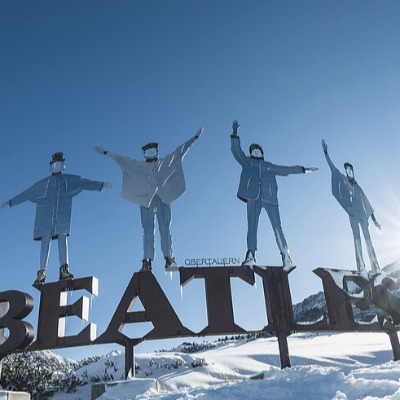Elan Gets Wood..

Slovenia is a small country. It takes all of half an hour to fly across it in a plane, either north to south or east to west. The first thing to notice looking out that small airplane window is the diversity of the landscape. It is incredible how such a small piece of land can have just about everything geography has to offer - sea, plains, hills ... But the most prominent in this kaleidoscope of impressions are the mountains and forests. Mountains are a synonym for skiing while forests make us think of wood. It is hardly surprising then that Slovenians are crazy about skiing. In every sense of the word. We like to ski. A lot. And we do it very well. And we know how to make skis, always have. For over 70 years, Begunje has been home to Elan, our national pride, and a company that has changed and improved the sport of skiing with innovations since its beginning.
Slovenia has all the necessary conditions for making great skis, the first being a deep love for winter and snow. The noted renaissance historian and writer Johann Weikhard von Valvasor wrote about skiers from Bloke in Slovenia in 1689. We could say that Slovenians have been skiing forever. It is in our national DNA. And it is every skier’s dream to make their own skis. The passion for using one’s own creation was perfected by Rudi Finžgar, legendary skier, ski jumper and innovator. He started making skis for himself and his friends and went on to make them for the partisans during the Second World War. After the war, he started making them for everyone. Rudi Finžgar was the father of Elan, a company born just after the war. The founding of Elan brought the Slovenian story of skiing together. The circle was completed. Elan represents not only the love and excitement for skiing but also knowledge, tradition, awareness and respect for Slovenian nature that has a wealth of wood, the most important ingredient of a good ski.

Slovenian wood
Slovenia is a land of forests. Woodland covers nearly sixty percent of the country. This means that practically every city, town and village lies next to a forest – an immensely complex ecosystem of plants, animals and microorganisms. Slovenian forests are home to 950 species of plants. 71 of those are trees - 10 conifers and 61 deciduous species. There are also a few foreign tree species that flourish after being brought from foreign lands. The most common species are beech and spruce. Forests provide a home for 95 species of birds, 70 species of mammals, 17 species of amphibians and 10 species of reptiles.
Our forests go through about 7.5 million tons of carbon dioxide per year, binding the carbon into wood and returning about 5.5 million tons of oxygen. They protect the ground from erosion and prevent landslides, hold in rainfall water and prevent excessive evaporation. Forests also regulate temperature and air humidity. Places in the vicinity of woods usually have a slightly lower temperature in the hot summer months. The main product of a forest is wood, a material that has been our faithful companion since the dawn of the human race. Its complex simplicity is a source of culture and art. It hides within it the sonorous tone of a violin, the knowledge of a book, and many other things. Wood is with us every step of the way from the cradle to the grave. Every tree is unique in its own way. We use wood to make furniture, build houses, create tools and accessories, ornaments and heat… and skis, of course. This noble natural material is at the heart of skis. But a ski is a tough animal. It goes to work when it is still dark outside. It works up a sweat in the coldest weather. Its stamina has no limits. A ski can be bent, flexed and tortured in just about every way and it will never complain. Nothing can get in the way of carving tight arcs, smearing turns, straight lining chutes and floating in powder. And it goes on all winter, November to May. None of it would be possible without wood.
“Wood is just about irreplaceable due to its elasticity and damping characteristics.”
Wood core
When Elan’s development engineer Marko Kozjek starts talking about wood his eyes light up: “Wood is the most important construction element of a ski. It is essentially a spacer that holds the distance between the top and bottom load bearing layers but due to its exceptional damping characteristics it is just about irreplaceable. It cannot be substituted neither by carbon fiber nor synthetic fillers. I cannot think of a single top of the line ski that doesn’t have a wood core. In theory, you could build a ski using artificial materials with the same static characteristics. But on snow it simply wouldn’t dampen vibrations and would not be able to track well.” Builders of ultralight aircraft and makers of violins would probably have similar things to say about the benefits of wood. It is said that the legendary Stradivarius violins are made of wood that is very similar to the Pokljuka spruce. Kozjek has an interesting note at hand: “If a spruce would never stop growing it would break at a height of 75 kilometers due to its own weight. How is that for amazing mechanical properties at given weight? Just about any other material would give up sooner, including steel.” Unfortunately, the art of ski making cannot rely on spruce wood very much since available lumber lacks homogeneity and has too many knots for skis. But that is not an unsurmountable problem. It puts me in mind of a comparison with the Rolling Stones, the most famous rock group in the world. When they were playing in China for the first time, the Chinese ministry of culture sent them a list of songs they thought were morally questionable and thus not appropriate for public performance.
“Good thing we have over 500 other songs to choose from” was Mick Jagger’s response. It is a similar story with skis and Slovenian wood. We have many other types of wood at hand for making skis. In the nineteen forties Rudi Finžgar made skis from ash because, the wood has a good flex and takes bending very well. “Ash can be cooked and bent. It has long and thick fibers and very few knots,” explains Kozjek. When ski constructions began to utilize fiberglass in the sixties, ash was replaced in most cases by more readily accessible beech wood. Ski technology then focused on rapid development of load bearing elements, especially using composite materials. At first, these structures were used only to counter longitudinal forces, leading to a lack of torsional stiffness. Further development led to multilayered composites of longitudinal, transverse and diagonal fibers that achieved required ski characteristics. But that created another problem. Composite materials were relatively heavy. The industry began turning to manmade materials instead of wood cores in order to reduce ski weight. But we soon made our way back to wood.

Especially touring skis needed to be as lightweight as possible, so designers used certain exotic woods. The use of synthetic cores also proved to be less than optimal in freeride skis where reasonable weight needs to be combined with appropriate torsional stability and response to varying snow conditions.
Poplar wood became the most common solution to these challenges. Certain skis also use combinations of different types of wood, allowing engineers to combine the best characteristics of each wood. One of the rare downsides of wood is its lack of homogeneity. If we take two poplar planks from different corners of Slovenia, their density may well vary quite a bit. “That problem can be solved relatively easily. We use cores made of wood slats glued together. This creates a homogenous material. With poplar our supplier pre-sorts the wood by weight - light and heavy poplar” explains Kozjek.
But modern trends and construction techniques have created a certain paradox. At first sight skis certainly do not look like they are made of wood. But they are. And even more. The wood core of a ski is everything. Besides, wood is worked by hand because certain operations simply cannot be performed using a machine. That is why the master craftsmen and women at Elan are a treasure trove of knowledge and experience. Most of all they all know very well why the Begunje factory goes through over 600 cubic meters of wood each year. Planks go into the factory as a raw material and have their shape changed lovingly into something much more appropriate for carving down snowy slopes.
“The wood core of a ski is everything. It is a mark of quality and trust in the product.”













